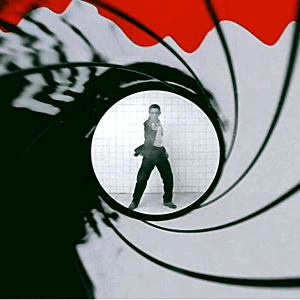
Casino Royale
A STIRRING CHANGE: In the opener, it's Bond, just Bond
Traditional dancing girls dropped from title credits of 'Casino Royale'
BY SHEIGH CRABTREE
Sheigh Crabtree wrote this story for the Los Angeles Times.
December 6, 2006
The crew expected a set crawling with sex kittens, but what they got instead was a couple of grizzled stuntmen and a chiseled blond Bond.
"When the crew realized there were not going to be any naked girls on set, some were a bit upset," admits Daniel Kleinman, the title designer behind the opening credit sequences for the last five James Bond films, including "Casino Royale," which is in theaters now. The lack of sultry dancing females in the segment was a radical departure not only for Kleinman but from four decades of setting up 007's cinematic adventures.
But just as the rest of "Casino Royale" deviates from aspects of the spy franchise's trademark iconography, so did Kleinman's two-day title sequence shoot this summer. The crew shot one day of stuntmen slugging it out, followed by a day with star Daniel Craig performing variations of the classic Bond first-person shooter stance.
"Everybody agreed the idea of using images of the iconic silhouetted dancing girls in the titles was not appropriate," Kleinman said. "In this film, Double-O is not totally formed as the James Bond everybody knows - the womanizing, slightly un-PC character." Kleinman learned of the new approach to Bond in January, when the producers enlisted the visual artist yet again. He was asked to design a documentary sequence that introduced Bond's novice assignments before the spy qualified for double-O status. But in early summer, Kleinman was beckoned to the Czech Republic.
There, director Martin Campbell had just wrapped the first reel, a gritty opening gambit that depicts the secret agent's precursory kills. Campbell feared there would be too much overlap between his pre-credits teaser and Kleinman's title sequence.
That's when the director suggested an overhaul.
"It would have been repetitive," Kleinman concedes. "But it was a bit of a shock to my system because I had spent a lot of time working out the first design, and it was getting pretty late in the day." So Kleinman crammed and took a 101 course on 007.
On the bookshelves he found the solution: The cover of a "Casino Royale" first edition, published in 1953, featured Ian Fleming's design of a playing card bordered by eight red hearts dripping blood.
"The hearts not only represent cards but the tribulations of Bond's love story," Kleinman says. "So I took that as inspiration to use playing card graphics in different ways in the titles," like a club representing a puff of gun smoke, and slashed arteries spurting thousands of tiny hearts.
He digitized the footage of the stuntmen and the star on an Inferno, a visual effects design system, at Framestore CFC in London. There he cut out the actors' silhouettes and incorporated them into about 20 digitally animated scenes depicting intricate and innovative card patterns that play for 3 1/2 minutes.
Seen in historic context with title designs that precede his, Kleinman says "Casino Royale's" credit sequence owes more to the jagged emblematic graphics of Saul Bass than to the cheeky erotica of Maurice Binder, who designed 14 Bond titles in all.
"I can't get too psychological with it because it is a title sequence," he says. "But it must be more than a flow of meaningless images." And there's some good news for the crew. "By the end of this one, 007 is more like the Bond we all know and love," says Kleinman, who is onboard to design the credit sequence for the next installment. "So I think those dancing girls may well come back again."















No comments:
Post a Comment